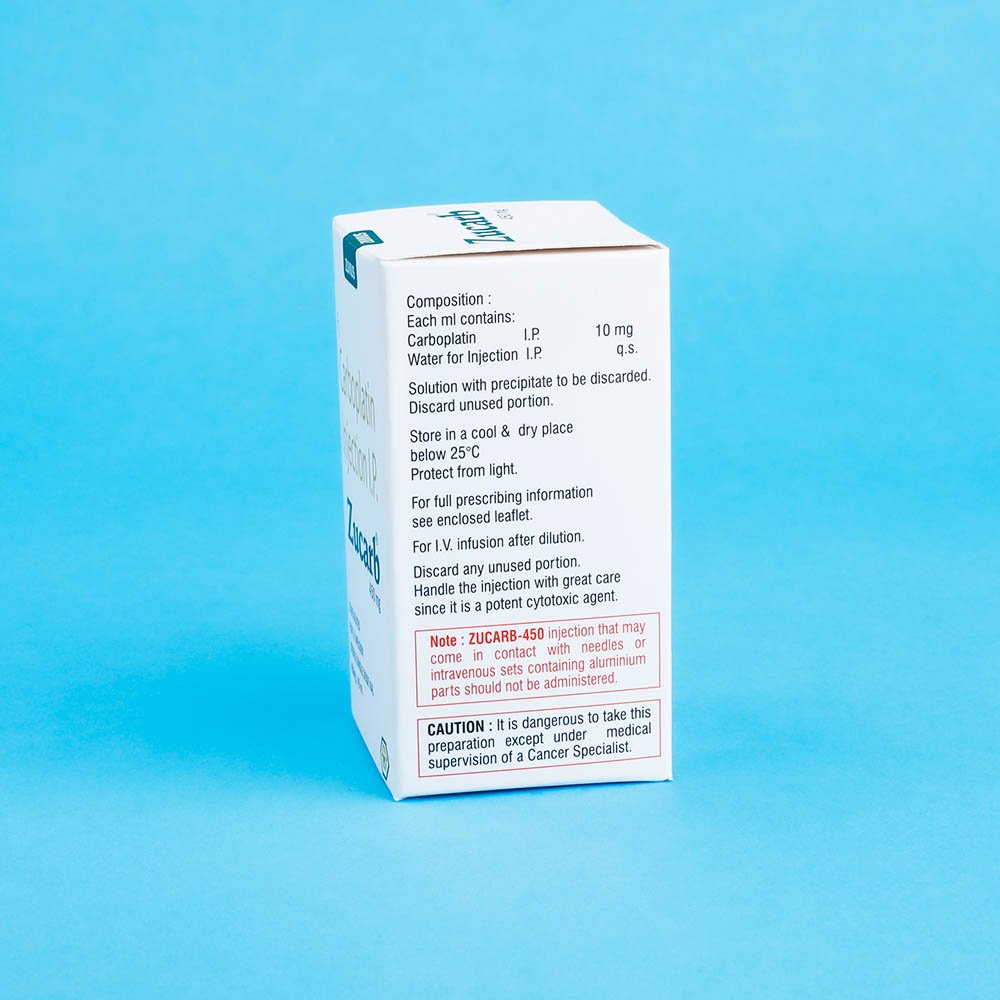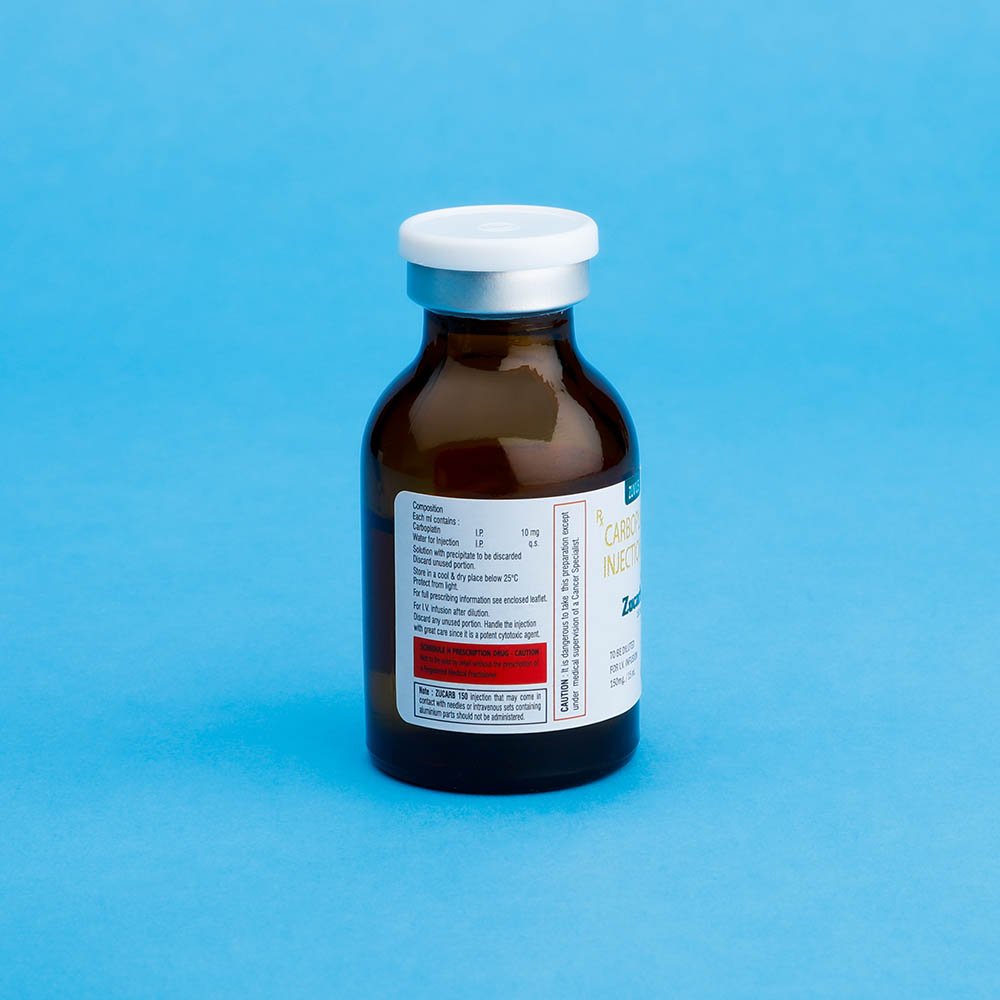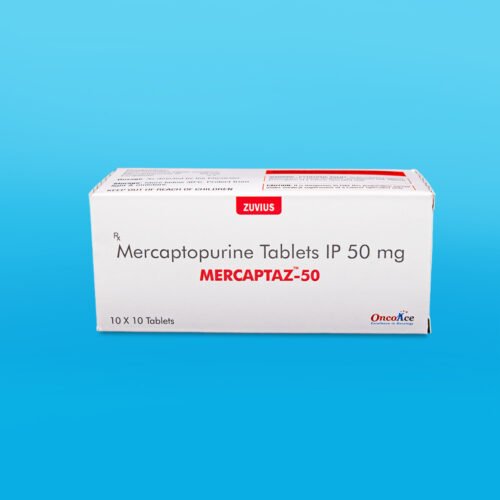Zucarb- Carboplatin Inj
Carboplatin
Strength: 150 mg / 450mg
Pack Size: 1 vial
Drug Class: Antineoplastic agents, Platinum compounds
Dosage and Administration:
NOTE: Aluminum reacts with carboplatin causing precipitate formation and loss of potency, therefore, needles or intravenous sets containing aluminum parts that may come in contact with the drug must not be used for the preparation or administration of Carboplatin Injection.
Single Agent Therapy:
Carboplatin Injection, as a single agent, has been shown to be effective in patients with recurrent ovarian carcinoma at a dosage of 360 mg/m2 IV on day 1 every 4 weeks (alternatively see Formula Dosing)/ in general, however, single intermittent courses of Carboplatin Injection should not be repeated until the neutrophil count is at least 2000 and the platelet count is at least 100,000.
Combination Therapy with Cyclophosphamide:
In the chemotherapy of advance ovarian cancer, an effective combination for previously untreated patients consists of:
Carboplatin Injection – 300 mg/m2 IV on day 1 every four weeks for six cycles (alternatively see Formula Dosing). Cyclophosphamide – 600mg/m2 IV on day 1 every four weeks for six cycles. For directions regarding the use and administration of cyclophosphamide please refer to its package insert. (See CLINICAL STUDIES). Intermittent courses of Carboplatin Injection in combination with cyclophosphamide should not be repeated until the neutrophil count is at least 2000 and the platelet count is at least 10,000.
Dose Adjustment Recommendations:
Pretreatment platelet count and performance status are important prognostic factors for severity of myelosuppression in previously treated patients.
The suggested dose adjustments for single agent or combination therapy shown in the table below are modified from controlled trials in previously treated and untreated patients with ovarian carcinoma. Blood counts were done weekly, and the recommendations are based on the lowest post-treatment platelet or neutrophil value.
| Platelets | Neutrophils | Adjusted Dose* (From Prior Course) |
| *Percentages apply to Carboplatin Injection as a single agent or to both Carboplatin Injection and cyclophosphamide in combination. In the controlled studies, dosages were also adjusted at a lower level (50% to 60%) for severe myelosuppression. Escalations above 125% were not recommended for these studies. | ||
| >100,000 | >2000 | 125% |
| 50-100,000 | 500-2000 | No Adjustment |
| <50,000 | <500 | 75% |
Carboplatin Injection is usually administered by an infusion lasting 15minutes or longer. No pre-or post-treatment hydration or forced diuresis is required.
Patients with Impaired Kidney Function:
Patients with creatinine clearance values below 60mL/min are at increased risk of severe bone marrow suppression. In renally-impaired patients who received single-agent Carboplatin Injection therapy, the incidence of severe leukopenia, neutropenia, or thrombocytopenia has been about 25% when the dosage modifications in the table below have been used.
| Baseline Creatinine Clearance | Recommended Dose on Day 1 |
| 41 – 59 mL/min | 250 mg/m2 |
| 16 – 40 mL/min | 200 mg/m2 |
The data available for patients with severely impaired kidney function (creatinine clearance below 15mL/min) are too limited to permit a recommendation for treatment.
These dosing recommendations apply to the initial course of treatment. Subsequent dosages shluld be adjusted according to the patient’s tolerance based on the degree of bone marrow suppression.
Formula Dosing:
Another approach for determining the initial dose of Carboplatin Injection is the use of mathematical formulae, which are based on a patient’s preexisting renal function or renal function and desired platelet nadir. Renal excretion is the major route of elimination for carboplatin. (See CLINICAL PHARMOCOLOGY). The use of dosing formulae, as compared to empirical dose calculation based on body surface area. Allows compensation for patient variations in pretreatment renal function that might result in either underdosing (in patients with above average renal function) or overdosing (in patients with impaired renal function).
A simple formula for calculating dosage, based upon a patient’s glomerular filtration rate (GFR in mL/min) and Carboplatin Injection target area under the concentration versus time curve (AUC in mg/mLmin), has been proposed by Calvert. In these studies, GFR was measured by 51 Cr-EDTA clearance.
| GALVERT FORMULA FOR CARBOPLATIN DOSING |
| Total Dose (mg) = (target AUC) X (GFR +25) |
| Note: With the Calvert formula, the total dose of Carboplatin Injection is calculated in mg, not mg/m2. |
The target AUC of 4-6 mg/mLmin using single agent Carboplatin Injection appears to provide the most appropriate dose range in previously treated patients. This study also showed a trend between the AUC of single agent Carboplatin Injection administered to previously treated patients and the likelihood of developing toxicity.
| % Actual Toxicity in Previously Treated Patients | ||
| Gr 3 or Gr 4 | Gr 3 or Gr 4 | |
| AUC (mg/mLmin) | Thrombocytopenia | Leukopenia |
| 4 to 5 | 16% | 13% |
| 6 to 7 | 33 | 34% |
Geriatric Dosing:
Because renal function is often decreased in elderly patients, formula dosing of Carboplatin Injection based on estimates of GFR should be used in elderly patients to provide predictable plasma Carboplatin Injection AUCs and thereby minimize the risk of toxicity.
PREPARATION OF INTRAVENOUS SOLUTIONS
Carboplatin Injection 10mg/mL is supplied as a Ready To Use (RTU) sterile solution in 5ml, 15ml, 45ml or 60ml vials. Total content of carboplatin per vial is described in following tableL
| Vial Strength | Diluent Volume |
| 50 mg | 5 ml |
| 150 mg | 15 ml |
| 450 mg | 45 ml |
| 600 mg | 60 ml |
Carboplatin Injection can be further diluted to concentrations as low as 0.5 mg/ml with 5% Dextrose in Water (D5W) or 0.9% Sodium Chloride Injection, USP.
When further diluted, Carboplatin Injection solutions are stable for 8hours at room temperature (25ºC). Since no antibacterial preservative is contained in the formulation, it is recommended that Carboplatin Injection solutions be discarded 8 hours after dilution.
Parenteral drug products should be inspected visually for particulate matter and discoloration prior to administration.
Cold Storage: no
Carboplatin Injection is supplied as a sterile, aqueous solution available in 50mg/5ml, 150mg/15ml, 450mg/45ml or 600mg/60ml multi-dose vials containing 10mg/ml of carboplatin for administration by intravenous infusion. Each ml contains 10mg carboplatin and Water for Injection, USP.
Carboplatin is a platinum coordination compound that is used as a cancer chemotherapeutic agent. The chemical name for carboplatin is platinum, diammine [1, 1-cyclobutane-dicarboxylato (2-)-0, 0’]-, (SP-4-2), and has the following structural formula:
Initial Treatment of Advanced Ovarian Carcinoma:
Carboplatin Injection is indicated for the initial treatment of advanced ovarian carcinoma is established combination with other approved chemotherapeutic agents. One established combination regimen consists of Carboplatin Injection and cyclophosphamide, have demonstrated equivalent overall survival between the two groups.
There is limited statistical power to demonstrate equivalence in overall pathologic complete response rates and long-term survival (≥ 3 years) because of the small number of patients with these outcomes : the small number of patients with residual tumor <2cm after initial surgery also limits the statistical power to demonstrate equivalence in this subgroup.
Secondary Treatment of Advanced Ovarian Carcinoma:
Carboplatin Injection is indicated for the palliative treatment of patients with ovarian carcinoma recurrent after prior chemotherapy, including patients who have been previously treated with cisplatin.
Within the group of patients previously treated with cisplatin, those who have developed progressive disease while receiving cisplatin therapy may have a decreased response rate.
Carboplatin Injection should not be employed in patients with severe bone marrow depression or significant bleeding.
Carboplatin injection as a single agent, has been shown to be effective in patients with recurrent ovarian carcinoma at a dosage of 360 mg/ m² IV on day 1 every 4 weeks (alternatively see Formula Dosing).
General:
Needles or intravenous administration sets containing aluminum parts that may come in contact with carboplatin should not be used for the preparation or administration of the drug. Aluminum can react with carboplatin causing precipitate formation and loss of potency.
Check with your doctor immediately if you notice any unusual bleeding or bruising; black, tarry stools; blood in urine or stools; or pinpoint red spots on your skin. Be careful when using a regular toothbrush, dental floss, or toothpick.
















